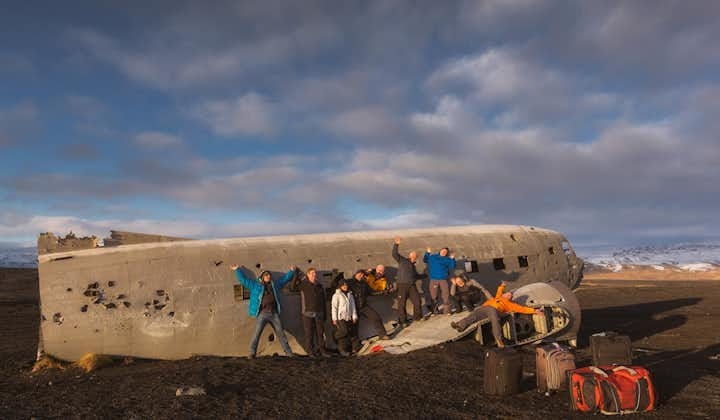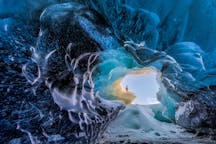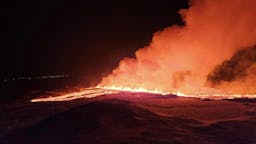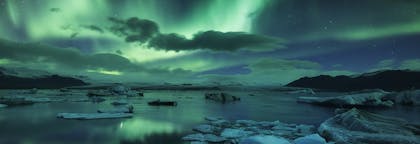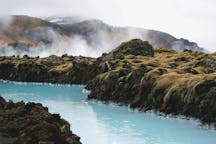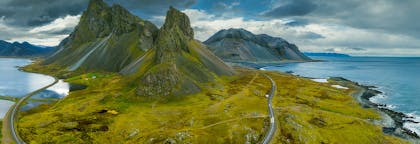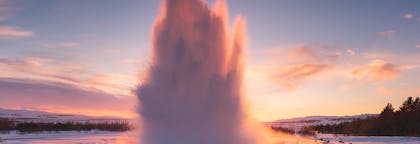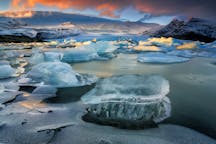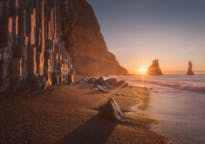描述
概括
描述
4月下旬至10月上旬,可以在冰岛环岛自驾游。如果不想太赶路又没有太多时间,这个8天7夜的环岛行程是这个季节最经典的基础环岛线路。沿着著名的冰岛一号环岛公路,尽享沿途美景。
蓝湖温泉、黄金圈、野性南岸的黑沙滩、瓦特那冰川国家公园、杰古沙龙冰河湖、北部米湖、阿克雷里,这些你耳熟能详的冰岛最著名的目的地都被囊括在这个环岛行程中。如果你希望在观光接触上有更多特色体验,还可以在预定时选择增加一些额外项目,比如在黄金圈增加刺激的雪地摩托、在南岸的索尔黑马冰川增加冰川徒步(Sólheimajökull)、在杰古沙龙冰河湖湖中船游,如果你喜欢动物,还可以增加骑马、观鲸。
这个环岛自驾的行程只在4月底至10月初开放,是因为冰岛的东部、北部地区多山路弯路,冬季来的早,且风雪更大,在冬季有不小的危险性,加上冰岛冬季日照短,自驾的优势远不如夏季明显。所以出于安全考虑,我们必须对大家的安全负责,推荐大家在冬季不要环岛。
您可以选择舒适或高端级别的酒店,均含早餐、安排私人卫浴,车型则有二驱、普通四驱、高端四驱三种级别供您选择。
冰岛人口少,旅游行业乃至各行各业资源紧俏。您预定这个套餐,将不用烦恼策划、预定需投入的大量时间和精力,让Guide to Iceland的旅行专家帮您选择最适合的冰岛旅行资源,并提供给您详细的行程单。我们会为您安排好全程的住宿和租车,根据您的航班时间把蓝湖温泉和附加项目合理的安排在行程中,根据您对附加项目的需求进行行程微调。
如果你想来冰岛环岛自驾游,就赶紧预定这个8天7夜的经典线路,轻松出行,畅享在冰岛自驾的乐趣吧!
包含
目的地
地图
旅游景点
特色项目
行程细节
汽车
汽车

Small car

Medium car

Premium car

Large car

SUV
个性化您的行程
第 1 天 - 雷克雅未克
第 1 天 - 雷克雅未克
- 雷克雅未克 - 抵达日
- More
到达冰岛凯夫拉维克国际机场后,会有租车工作人员在机场接机大厅等待,把车交给您,并向您解释如何在机场还车及安全驾驶等注意事项。接下来您便可以驾车前往首都雷克雅未克的酒店。
如果时间尚早,您可以游览市区,利用今天剩余的时间逛逛博物馆、艺术廊、走访雷市著名的地标,在咖啡厅、餐厅坐一坐补充能量。
如果您的航班在下午4点前到达冰岛,可以选择取车后直接前往蓝湖温泉。蓝湖温泉在凯夫拉维克国际机场和首都雷克雅未克之间,这样安排最能节省宝贵的行程时间,不走回头路。如果离境日的航班时间在下午,也可以选择离境日的上午去蓝湖。如果两天都不合适,我们会合理的安排在其它日子。预定时,您还可以选择把蓝湖温泉从舒适门票(含浴巾、一杯饮品、面膜泥)升级为高级门票(舒适基础上再增加拖鞋、浴袍、蓝湖Lava餐厅定位及一杯气泡酒,且排队时间短)。
特色体验
住宿
第 2 天 - 冰岛南岸
第 2 天 - 冰岛南岸
- 冰岛南岸
- More
- 辛格维利尔国家公园
- 盖歇尔地热区
- 黄金瀑布
- Seljalandsfoss Waterfall
- Skogafoss waterfall
- Reynisfjara black sand beach
- Vik Village
- More
第二天,您将来到冰岛广为人知的黄金圈景区,这里以众多自然奇观而名声大振。
黄金圈三大站的第一站是辛格维利尔国家公园(Thingvellir National Park),在这里您可以行走在欧洲-美洲两大板块的大西洋中脊的裂谷,享受脚踏两大洲的成就感,在史费拉裂缝(Silfra)进行浮潜,探索这个曾在冰岛历史上扮演过重要角色的地方。
下一站是Haukadalur地热小镇,该小镇以间歇泉而闻名。在这里您可以看到史托克Strokkur间歇泉和盖谢尔间歇泉。
接着,驾车向前几公里,便可到达冰岛最著名的景点-黄金瀑布(Gullfoss),周围有一条小道可以通向瀑布边缘,站在那里,您可以最直观最真实地感受到瀑布的雄伟气势和自然的力量。
离开黄金圈后,来到备受青睐的Kerið火山口(这也是您驶上环岛公路,到达南岸前不可错过的地方)。接下来,您会经过壮丽璀璨的塞里雅兰瀑布(Seljalandsfoss),和与之齐名的斯科加瀑布(Skógafoss)。继续向南,沿着临近维克镇的海岸线,停驻在由于火山喷发造成的奇异黑沙滩,一睹魔幻般Dyrhólaey岩门石洞和雷尼斯德兰格玄武岩石柱群。
可选额外项目:
1.朗格冰川雪地摩托:如果您喜欢刺激,就一定不要错过雪地摩托,这是冰岛最受欢迎的户外项目之一。这个项目的集合地点在黄金大瀑布的信息中心外停车场,所以适宜加在这一天的行程中。(最低年龄6岁, 需要您持有有效驾照,如无驾照只能做乘客)
2. 丝浮拉大裂缝干衣浮潜:体会在两大地质板块间遨游的超然体验,冰岛最酷的特色项目之一。(浮潜项目需要您会游泳并年满12岁)
3. 骑马:2小时轻松骑马,无需经验,最低年龄12岁。
注:这一天只能增加一个额外项目,否则时间不够用。
特色体验
住宿
第 3 天 - 冰岛东南部
第 3 天 - 冰岛东南部
- 冰岛东南部
- More
- Jokulsarlon Glacier Lagoon
- Skaftafell Nature Reserve
- 斯瓦蒂瀑布
- 钻石冰沙滩
- More
第三天,您将去往位于瓦特纳冰川国家的斯卡夫塔山Skaftafell地区,在这里既可以欣赏风景,还可以参加各种各样的户外活动。您还可以选择出发前先去索尔黑马冰川参加冰川徒步项目。
出发前,您还可以选择前往米达冰川内的卡特拉冰洞,探索冰川内部奇妙景色。
如果您喜欢徒步,斯卡夫塔山地区有多条徒步线路可供选择,满足您的不同选择偏好和需求,其中一条就通往美丽的斯瓦提瀑布(Svartifoss)。
当您回到环岛主路,首先映入眼帘的就是杰古沙龙冰湖(Jökulsárlón)-这里不仅是冰岛最著名的景区之一,也是最顶级的摄影天堂;您可以选择参加付费项目-冰湖船游,穿梭于宁静、形状各异的巨大冰山之间。在冰湖对面,是一片“钻石冰沙滩”,搁浅在黑沙滩的冰石让你觉得宛如来到了《爱丽丝梦游仙境》中的梦幻世界。
行程单中还有更多小众景区可选择游览。
可选额外项目:
1. 米达冰川卡特拉冰洞:最低年龄8岁
2. 斯卡夫塔山冰川徒步:最低年龄8岁
3. 杰古沙龙冰河湖两栖船游:船游在每年的5月至9月之间运营,但是也可能会受到天气的影响。如果入夏早、入秋晚,4月和10月也有一定的可能会可以船游,但是这个完全取决于当时的天气状况。
4. 杰古沙龙冰河湖快艇船游:6月至9月运营,最低年龄6岁。
小贴士:霍芬镇(Höfn,又名赫本镇),这里是很著名的吃冰岛龙虾的地方。如果您是美食爱好者,记得提前定位。
特色体验
住宿
第 4 天 - 冰岛东峡湾
第 4 天 - 冰岛东峡湾
- 冰岛东峡湾
- More
- Vestrahorn
- 亨吉瀑布
- Hallormsstadaskogur Forest
- 沃普纳菲厄泽
- More
第四天,您将沿着东部峡湾地区北上,沿途经过秀丽静谧的峡湾小镇。东部峡湾蜿蜒曲折,海岸线美不胜收。每一个拐角处都是另一片天地,一路上您将路过多个小渔村,可以按照自己的喜好选择停留、游览。
东部峡湾地区的村镇是冰岛开发程度最低的地区,您可以了解冰岛古老的历史和文化,夜晚留宿东部地区的中心-埃伊尔斯塔济镇(Egilsstaðir)或周边地区。
特色体验
住宿
第 5 天 - 北部冰岛
第 5 天 - 北部冰岛
- 北部冰岛
- More
- Lake Myvatn Area
- Borgarfjordur eystri fjord and valley
- 黛提瀑布
- 众神瀑布
- More
第五天,您将驶向冰岛北部的米湖区。北部米湖区以其独特的地热景色闻名,包括Námaskarð地热区、Skútustaðagígar伪火山口、Dimmuborgir黑色城堡火山岩群和Krafla火山(人气颇高、到访者众多的冰岛火山)。
结束了一天的长途跋涉和观光,可以去米湖天然地热温泉泡温泉,缓解一天的疲劳。
如果您希望多走访一些地区,还可以北上到被称为欧洲观鲸之都的小镇-胡萨维克,乘船出海赏鲸。
可选额外项目:
1. 米湖天然温泉
2. 胡萨维克观鲸团
3. 胡萨维克观鲸+观海鹦船游旅行团:最低年龄7岁
特色体验
住宿
第 6 天 - 冰岛西北部
第 6 天 - 冰岛西北部
- 冰岛西北部
- More
- 巨魔半岛
- 侯拉尔
- More
第六天,参观童话般的阿克雷里。阿克雷里与其说是一个城市,更像一个可爱的海边小镇,这里有许多俏皮的商店、博物馆,以及世界最北的植物园,是行程中一个调整步调、放松的好机会。
接着,继续向Skagafjörður峡谷进发(该峡谷以数量惊人的冰岛马而闻名);穿过山岳连绵、景色优美的Tröllaskagi渔村(这里是Siglufjörður峡湾古老的鲱鱼渔村),放松身心远眺周遭风光。
可选额外项目:
1. 北部冰岛一小时骑马旅行团(最低年龄为12岁)。
2. 阿克雷里观鲸团。
特色体验
住宿
第 7 天 - 雷克雅未克
第 7 天 - 雷克雅未克
- 雷克雅未克
- More
- 德尔达图赫菲温泉
- 赫伦瀑布群 & 儿童瀑布
- 雷克霍特
- Borgarvirki堡垒
- 犀牛石Hvítserkur
- Borg a Myrum church and farm
- More
第七天,您可以探索冰岛西部的众多景区,包括位于博尔加内斯(Borgarnes)古冰岛人定居博物馆和Deildartunguhver-欧洲最大的天然地热泉。继续前行,不可错过的还有赫伦瀑布(Hraunfossar,又名熔岩瀑布)和儿童瀑布(Barnafossar)。历史爱好者还可以参观位于雷克霍特(Reykholt)的Snorrastofa,这里是13世纪Snorri Sturluson书写Heimskringla萨迦文学的地方。
如果希望有更多时间在首都购物休闲,今天可以早点出发,直接返程首都,体验世界最北首都的独特文化。
可选额外项目:
1. 朗格冰川冰川隧道:探索世界首个冰川内的人工隧道。
2. 火山岩洞洞穴探险:地理地质爱好者的天堂。
3. 火山内部遨游:冰岛是全世界唯一一个可进入火山内部的国度,这是冰岛夏季最受欢迎的特色项目。5月10日至10月31日之间运营。(最低年龄8岁)
特色体验
住宿
第 8 天 - 雷克雅未克
第 8 天 - 雷克雅未克
- 雷克雅未克 - 离开日
- More
- 克莱瓦湖
- 克里苏维克
- 古纳威尔热泉地热区
- More
今天在您离境前,需去凯夫拉维克机场还车;如果您的航班时间在傍晚,还可以增加一些额外项目,让行程更丰富。可以把蓝湖安排在离境前,作为本次自驾的最后一个小高潮,被火山石包围的蓝湖温泉宛如仙境, 湖水中富含着矿物质,对皮肤非常有益,也具有一定的疗愈效果。您可以在这里彻底放松身心,为冰岛之行画上圆满句号。
欢迎再来!
特色体验
建议携带
小贴士
自驾团可以选择以冰岛国际机场或以首都雷克雅未克市区为起点及终点。
您需要持有合法的驾驶执照,有一年以上的驾龄(驾照需办理英文公证件)。
取车需要出示信用卡进行授权担保。
某些自选活动可能要求您持有有效的驾驶执照,或者您可能需要向运营商发送其他信息。如果您选择浮潜或潜水,可能需要出示医疗文件,而且参加者需要会游泳。
在Guide to Iceland定自驾套餐,我们可以免费提供行程单送签信,作为您申请签证的辅助材料。预订后,请提供您的航班等旅行信息,大约需要7-14个工作日后,您可收到送签信。
蓝湖温泉为冰岛热门景点,为确保服务质量而控制入场人数,旺季期间可能存在门票供不应求的情况,建议确认日期后尽快预订套餐。预订成功后,客服专员会根据您的行程设计入场时间。若已订满,则为您进行相应调整,安排同样精彩的行程。
真实评价
类似的旅行套餐

将冰岛最大的旅行平台下载到您的手机上,在一个App中管理您的整个行程
使用手机摄像头扫描此二维码,点击链接,即可将冰岛最大的旅行平台添加到您的手机中。添加您的电话号码或电子邮件地址以接收包含下载链接的短信或电子邮件。
